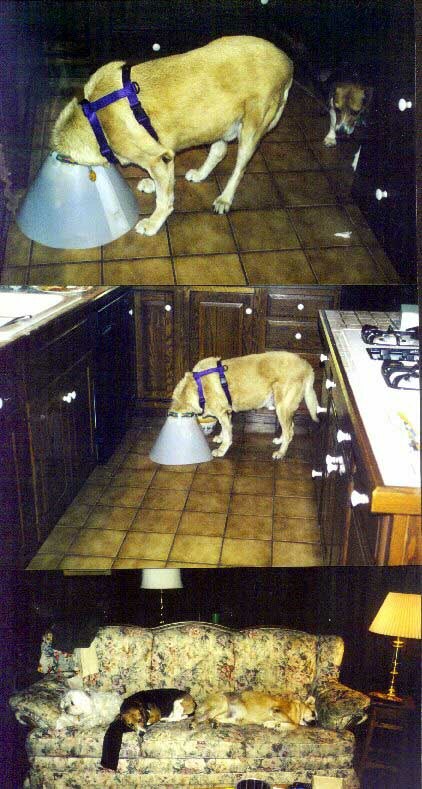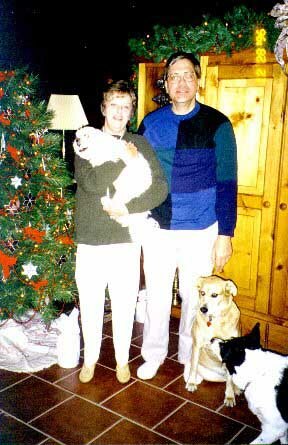About eleven years ago some uncaring human dumped this helpless puppy
on one of our sod farms.
Our son, Brian, had seen the dog but paid little attention the first
few days. When a severe thunderstorm
came up one night Brian went out to the farm looking for this puppy.
There was an old train caboose
on the property and lightening, thunder and pouring rain did not dissuade
our son from going out and
retrieving this hapless pup from underneath the caboose. Brian brought
Alex to our house, everyone
soaking wet, and asked me if I could keep him until another home was
found. I reluctantly agreed for
a one-week period because we already had three other dogs at the time.
The rest is history.
Alex never had an accident in the house and was easily trained except
for some chewing that went on
during the puppy stage. The usual items chewed were throw pillows and
shoes. However, the bedclothes
were another issue. We have a king-sized bed and that was an expensive
period of time. After we got
through this period Alex was an exemplary example of a fine mutt, always
well-behaved and loving,
with one exception. My mom, shown with Alex, was staying here recouping
from a broken arm and
her minister came to visit. I had to actually put Alex in the bedroom....he
didn't like this man one
little bit and made it totally obvious to everyone....especially the
minister!
About four years ago I noticed a drastic change in his coat and behavior
and had repeatedly
asked about possible thyroid problems but was told he was fine. This
last spring, when I took the
gang (4) in for their usual heartworm check, I again asked about thyroid
problems and told the
vet that I suspected that he may be diabetic. I was simply told there
was not a problem and he
was fine. We go to a local veterinary clinic where there are always
a number of vets on hand.
I have been diabetic most of my life but went undiagnosed until 1989.
Thus said, I know
personally the symptoms of uncontrolled blood sugars. On the morning
of June 5th, 2002 I awoke
to the sound of running water. Half-asleep, I thought it was my husband
in the bathroom but when
I reached over I found him to be still lying in bed. I awakened Roger
and we went to check out the
noise. There was Alex in the hallway, peeing a lake while in a daze.
That did it! Alex had the typical
symptoms of uncontrolled diabetes and was even staggering. We made
sure we got him to the vets
that day and I insisted Alex be checked for diabetes. His blood sugars
were over 600 with a
blood test and his ketones showed "Large" on the Keto-Diastix. He was
started on 14 units of
Humulin N on the 7th of June. After only a week and a half, looking
at Alex's curve, it was
apparent that the N was not providing the needed duration. It was also
becoming painfully
apparent that, in my opinion, vets do not get enough of an education
covering diabetes.
I am not faulting vets, but I will fault vet schools because, in my
opinion, they do not
provide a good education covering this disease and how to control it.
I started looking for
information concerning pet diabetes on the internet and that is how
I found the Queenie website.
Although I knew plenty about human diabetes, I did not know how much
of that knowledge could be applied to dogs.
After three weeks I started voicing my objections to the standard protocol
of diabetes
treatment in animals. Alex was still running an easy 500-600+ most
of the time and we had
upped the N considerably. This would have been totally unsatisfactory
if Alex had been
a human and I was especially concerned since I had learned that dogs
can form cataracts
so quickly. I made an appointment to see one of the owners of this
practice to discuss the situation
and gave her information on the insulins I currently use, Lantus and
Humalog. We looked over
all the bg values and patterns, which clearly showed that the N had
not worked over this period
and, further, it wouldn't, at least not at this time and not in this
dog. We could not increase the
dosage much more due to the risk of hypoglycemic incidents, something
I desperately wished
to avoid. Dr. Yvonne Nadler agreed and we set off to find research
using Lantus in animals.
The new Lantus that came out in 2001 is for basal insulin needs only.
The body has
two kinds of insulin needs, basal and bolus so to speak. The pancreas
puts out a small amount
of insulin all the time and this is called the basal. When a person
or animal eats, extra insulin
is needed to cover the rise in glucose from the meal and this is called
a bolus. The normal pancreas
runs this operation very smoothly and efficiently, keeping blood glucose
in a range of about 70-150.
The diabetic's pancreas cannot preform this feat for various reasons.
The other insulin is called
Humalog and came onto the market in 1996. The Humalog is used to cover
the postprandial rise
from meals and works consistently and efficiently. It is normally taken
at mealtime, starts to
work in 5 minutes and peaks at two hours, at which time the action
of the insulin drops
dramatically. In order to keep sugars within normal range using these
two insulins together, you
need to use the Lantus to cover the basal insulin needs and the Humalog
to cover meals.
Once the correct dosage of each insulin is found, the resulting curve
is beautifully flat. Also, there is
less chance of hypoglycemic episodes with both of these newer insulin
types. The Lantus has a relatively
flat profile to it with only a slight peaking action about 8 hours
after injection, therefore, less lows if at all.
With Humalog, using a ratio of units to carbohydrates, you can cover
a meal nicely and the insulin gets in
there, does its job and then gets out, also resulting in less hypoglycemic
incidents if the ratio is matched well.
Dr. Yvonne Nadler and I discussed using the Lantus and Humalog in Alex
and I provided her
with information covering Lantus. We had a very real problem in that
we couldn't get our hands on
much information using the Lantus in animals. She knew quite well the
action of the rapid-acting Humalog
as they use this insulin under emergency situations to quickly reduce
high glucose levels but was not
familiar using it to cover meals. It was a joint decision to give this
combination a try though we were
flying a bit blind when we first started. Dr. Nadler also stated that
she would in no way give this
a try under normal circumstances but since we were doing home blood
testing and I was
familiar with this protocol and both insulins we were going ahead with
the "experiment"
rather than leave Alex in his present condition, mostly uncontrolled
and not feeling well.
Because of a few problems encountered, and lack of knowledge concerning
the use of Lantus
in animals, I made an appointment with my endocrinologist for some
help. Dr. D. filled in the blanks in
about two minutes! He stated that as far as he was concerned we had
made an exceptional choice in
insulins and that we should have changed earlier. He was in a rush
as he had had an emergency
and was way behind schedule but as he was running out the door....he
added that we had a
real problem with the food! Well, we do, but that has been taken care
of by turning to
home-cooking rather than using any commercial dog foods.
It has now been three months since Alex was first diagnosed and it has
been an extremely
frustrating time in trying to regulate a dog that has turned out to
have food allergies or intolerances
that affect his glucose. With the use of the Lantus and Humalog or
the Regular, Alex is regulated
quite nicely and we are at the point of fine-tuning any small problems.
The rapid-acting Humalog
wasn't producing quite enough duration to cover Alex's glucose metabolism
and we have temporarily
changed to using Regular, a short-acting insulin used to cover foods
also. Though an older, more
unpredictable insulin type, the Regular provides longer duration. Once
we get the food down a little better
we are going to try to go back to the Humalog simply because it has
a more predictable activity profile.
Alex has now gained back a little over 6 pounds of the 13 he originally
lost. He is no longer moping
around, hiding in a cool place in the bathroom. Alex's tail is up,
ears perked, greeting friends
and family once again, and he has a bounce to his steps that I haven't
seen in a long, long time. He is
also now back in the family room during the evenings, or by my side
most of the day. He's pretty much
back to normal and we knew that for sure when we went back to the routine
battle of Alex wanting to
go for rides in the car! He doesn't behave 100% well when you go to
leave....he wants to go with you!
And further.....it's great to have that battle back!
Diabetes is a continuing battle, whether it be in humans or
animals,
and though there is no cure, it can be controlled.
If one insulin doesn't get the job done, another one or combination
of insulins
will, in most cases. I'm very lucky that I have a vet who is honest,
cares about the pets and clients,
and was willing to give the Lantus/Humalog combination a try. It is
absolutely wonderful to be
working together for the benefit of a pet, Dr. Nadler with her expertise
as a vet, and my years
of experience being a diabetic and knowing first-hand how many of these
various insulins act.
Together we're working to get the job done and I sure owe Yvonne a
big thank-you for listening
and trying something new when the standard therapy didn't work. Dr.
D., my endocrinologist,
gets another thank-you from me as he shared information he knew concerning
the use of Lantus in dogs.
Sharing knowledge and experiences truly works wonders, just like on
the Queenie site. Thanks also go
to many on the website who helped me with my questions, and you know
who you are.
Margo Hupe
Alex had successful cataract surgery!


|